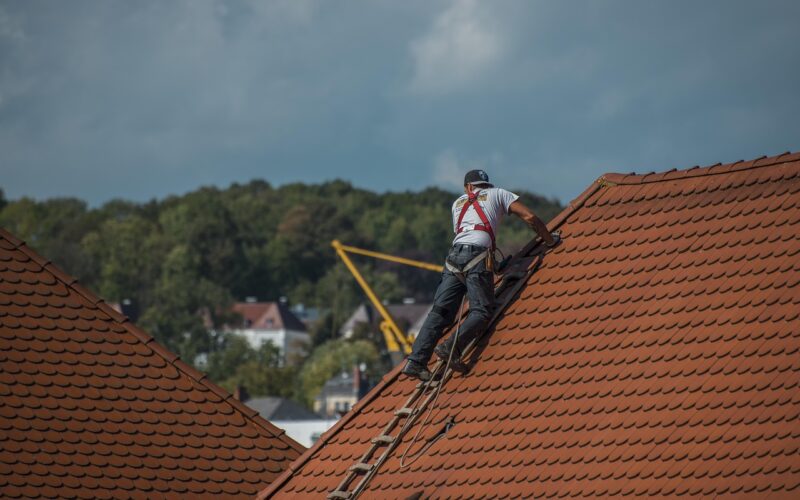Picking the right roofing material is a big deal for any homeowner.
Tile roofing, in particular, has been around for ages and is still a favorite in all sorts of climates.
There’s something about its look and the promise of a long lifespan that keeps drawing people in when it’s time for a new roof.
Tile roofing offers impressive durability with lifespans of 50+ years, excellent fire resistance, and energy efficiency, but comes with higher upfront costs and installation challenges compared to other roofing materials.
While extremely durable and weather-resistant, tile roofs can still crack from heavy impacts, requiring occasional maintenance despite their reputation for longevity.
On top of that, tile roofing brings a unique charm that can bump up your home’s value. It comes in a surprising range of styles, colors, and materials, so you can match it to just about any architectural vibe.
Plus, it can provide better insulation than some other options. Of course, it’s not all sunshine and roses—knowing the ups and downs will help you decide if tile roofing makes sense for your budget, house style, and plans for the future.
What Is Tile Roofing?
Tile roofing is, at its core, a system that uses individual tiles—either natural or manufactured—to shield your home from the elements. These tiles overlap or snap together, creating a barrier between your house and whatever the weather throws at it.
The most common types of roof tiles include:
- Clay tiles: Classic terracotta tiles made from natural clay and fired at high temps
- Concrete tiles: Made from a mix of sand, cement, and water
- Slate tiles: Thin, flat pieces of natural stone
Clay tile roofs have been around for centuries, popping up in all sorts of cultures and climates. Their warm, reddish-orange hue gives homes that Mediterranean or Spanish character you can’t really fake.
Concrete tiles are a bit more versatile in color and usually cost less than clay. These days, manufacturers can make concrete tiles look like just about anything—clay, slate, even wood if you squint.
People love tile roofs for their toughness. Installed right, a tile roof can stick around for 50-100 years, give or take, depending on what it’s made of and how wild your local weather gets.
Most roof tiles have that signature curve or S-shape, though you can find flat versions too. The shape helps water run off instead of pooling up and causing trouble.
The catch? Tile roofing is heavy—way heavier than asphalt shingles. Your home needs to be built or beefed up to handle all that extra weight, whether you’re going with clay, concrete, or slate.
Pros Of Tile Roofing
One of the biggest draws of tile roofing is its longevity. With some basic maintenance, these roofs often last 50 years or more. Not many roofing options can say the same.
There’s also the matter of durability. Tile roofs don’t rot or decay like some other materials do. And pests? Not really a problem here, which is a nice bonus.
For weather resistance, tile roofing is tough to beat. It stands up to high winds, pelting rain, and relentless sun without much fuss.
Looks matter, too. The aesthetic appeal of tile roofs is hard to miss—they come in a bunch of colors, styles, and textures, so you can really make your place stand out.
Another big plus: tile roofing is fire-resistant. If you live in a fire-prone area, that extra peace of mind is no small thing. Sometimes, you might even get a break on your insurance.
There’s an eco-friendly angle here as well. Concrete and clay tiles are made from sustainable materials, and when they finally wear out, you can recycle them.
Tile roofs also help with energy efficiency. They naturally insulate, so your home stays cooler in the summer and warmer in the winter. That can mean lower energy bills, and who doesn’t want that?
Homes with tile roofing often see a jump in resale value. People recognize the quality and longevity, so it’s not a bad investment if you’re thinking long-term.
Maintenance is pretty chill. As long as you check in now and then and clean off debris, a tile roof should keep looking good and doing its job.
Cons Of Tile Roofing
But let’s not sugarcoat it—tile roofs do have their downsides.
High Cost – Tile roofing is pretty pricey compared to other options. Upfront, you could pay two or three times what you would for asphalt shingles.
Installation Challenges – You really need pros for this job. The weight and complexity mean you can’t just DIY it, and that specialized labor drives up the total cost.
Weight Concerns – These things are heavy—sometimes over 10 pounds per square foot. Your house might need extra support just to handle it.
Fragility Issues – Here’s the irony: while tile roofs are tough against weather, they can crack or break from impact. A heavy branch, hail, or even someone walking up there can do some damage.
Maintenance Requirements – When a tile breaks, you can’t ignore it. You’ll need to swap it out quickly to avoid leaks. Broken tiles usually mean calling in a pro, which adds to the long-term costs.
Pest Concerns – Sometimes, bugs or critters find their way into the gaps between tiles and the underlayment. Not a huge issue, but it can happen, and it’s another thing to keep an eye on.
Energy Efficiency Variations – Tile roofs are generally good for insulation, but if you skip proper underlayment or insulation, you could still see higher energy bills in extreme climates.
Complex Repairs – Got an older tile roof? Finding matching tiles for repairs can be a pain and, honestly, a bit expensive over time.
When Tile Roofing Makes Sense
Tile roofing really shines in warm, sunny places. If you live somewhere like the Southwest, you’ll see tile roofs everywhere—they just handle the heat, wind, and even fire so well. They’re built for it.
Architectural styles like Mediterranean, Spanish, and Mission look their best with tile roofing. Those curved clay tiles just fit the look, no question.
If you’re planning to stay put for a while, tile roofing can make financial sense. Sure, it costs more upfront, but clay and concrete tiles can last 50-100 years if you take care of them. That’s a long time to not worry about your roof.
Energy efficiency is a big deal for a lot of folks. Tile roofs can help cut cooling costs in hot weather. The airspace between tiles acts as insulation, so your AC doesn’t have to work as hard.
If you care about the environment, you’ll like that tile roofs are made from natural stuff. No weird chemical preservatives, and they can be recycled when their time is up.
That being said, your house needs to be up to the challenge. Concrete or clay tiles can weigh anywhere from 600 to 1,100 pounds per square (that’s 100 square feet), so the structure has to be solid.
For those who want to keep things low-maintenance, tile roofing is a solid pick. You might need to replace a tile now and then, but overall, there’s not much to fuss over compared to other roofing types.
Conclusion
Tile roofing’s got some serious staying power, with a lifespan that can top 50 years. If you’re thinking about the long haul, it’s not a bad investment for homeowners who want something that’ll last.
The energy efficiency angle is a real bonus, too—tile roofs can help shave down heating and cooling bills, and let’s be honest, that’s something most of us can get behind. Plus, there’s the eco-friendly factor for anyone who cares about sustainability.
On the looks front, tile roofs have a distinctive beauty that can really boost a home’s curb appeal. Some folks even say it bumps up property value, though that probably depends on where you live.
But, yeah, the price tag up front is no joke. Tile roofing almost always costs more than your basic asphalt shingles, and that’s a big hurdle for a lot of people.
Another thing—these tiles are heavy. We’re talking 10+ pounds per square foot. Some homes just aren’t built for that kind of weight, so you might need extra structural support, which can drive up the cost even more.
Maintenance isn’t much of a hassle most of the time, but tiles can crack if you’re not careful—think falling branches or someone walking up there. Repairs aren’t constant, but they do pop up now and then.
Honestly, it’s worth sitting down and weighing all this against your budget, your house itself, the climate in your area, and what you want long-term. If you’re able to swing the upfront costs and your home can handle it, tile roofing could pay off with decades of protection and a look that stands out.
It’s smart to talk things over with a roofing pro—they can tell you if tile’s a good fit for your place and give you a clearer idea of what you’ll actually spend.








